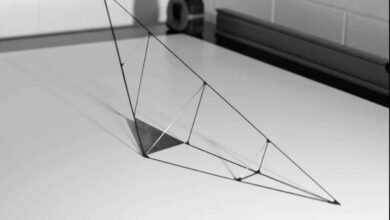Why physicists think geometry is the path to a theory of everything


Can you imagine the imprint a four-dimensional hexagon might leave as it passes through your three-dimensional kitchen table? Probably not, but some people can.
One such person was mathematician Alicia Boole Stott, daughter of logician George Boole. Early in the 20th century, she made models of the shapes four-dimensional objects would create when passing through three-dimensional objects. Decades later, when mathematicians could check such things using computer programs, they found Boole Stott had possessed an uncanny gift for getting these shapes right.
This story is part of our Concepts Special, in which we reveal how experts think about some of the most mind-blowing ideas in science. Read more here
For most of us, geometry conjures up thoughts of pencils, rulers, triangles and circles. It means those complicated questions you got asked at school involving parallel lines and angles. But as Boole Stott’s story shows, researchers have been taking geometry way beyond this for some time.
Geometry can stray far from the comprehensible world of two- and three-dimensional shapes – and in so doing, it can be extremely illuminating. Perhaps the best example is general relativity, Albert Einstein’s theory of gravity, which joins the three dimensions of space with time, creating a four-dimensional stage on which everything in the universe plays out.
But geometry can also make use of dimensions that aren’t physically real. Think of meteorology, for instance, where a point in the atmosphere can have many “dimensions” – latitude, longitude, temperature, pressure, wind speed and so on.
Researchers map these dimensions as shapes that extend into higher dimensions to help understand the workings of the atmosphere. “From things like this, you can apply mathematical models and actually work out what happens to [those properties] in many dimensions,” says mathematician Snezana Lawrence at Middlesex University in London.
For theoretical physicists, extra dimensions seem to be a necessary part of any full description of the universe, with some proposing that our reality is a “projection” from a higher dimension, for instance. This may sound outlandish, but if physicists make certain simplifying assumptions related to this idea, it suddenly makes it possible to carry out calculations to do with fundamental particles and black holes that are otherwise impossible.
Some physicists are banking on even stranger geometrical ideas being a route to a “theory of everything”, a single framework that explains the cosmos and everything in it. One of these is the “amplituhedron”, a mathematical object developed by Jaroslav Trnka at the University of California, Davis, and Nima Arkani-Hamed at the Institute for Advanced Study, New Jersey. Think of this as an abstract, multi-dimensional crystal, the properties of which provide an alternative way of describing the fundamentals of particle physics.
Or there is “causal dynamical triangulation”, developed by Renate Loll at Radboud University in the Netherlands. This stitches together an ensemble of geometrical shapes to create a description of space-time that seems to have some of the properties of both quantum theory and general relativity – two ideas that are normally incompatible. It is, she says, not just an abstract geometrical notion, but a testable reflection of the universe’s real properties that could be mirrored in our observations of the cosmic microwave background radiation that fills the whole of space.
Neither of these ideas yet amount to a theory of everything. But some suspect that to have any hope of finding one, we need a fresh vision for physics – and there is an increasing sense that this might be written in the language of geometry. Whether that is true or not, geometry is definitely more than hexagons – even four-dimensional ones.
Read the other stories in this series using the links below:
Topics:
Source link




